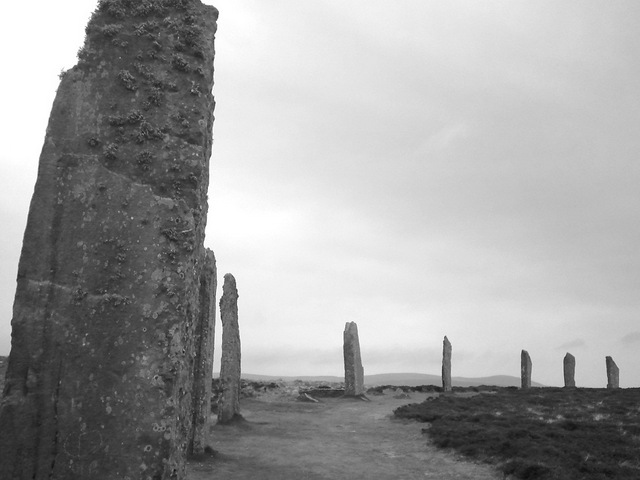Torchlight on Orkney

“Are you here for the diving?”
The first time I was asked took me aback, though not unpleasantly. I assumed I must look like the adventurous type. I was carried from the Tourist Information office by a more suave walk than the one that carried me in.
“She asked if I was here for the diving” I said smugly to my friend.
The second time I was asked, I had to admit that I wasn’t a diver. “You’re not here to dive Scapa Flow?” the landlady of the Flattie Bar asked. I replied that I wasn’t but I’d gladly dive into a pint of Scapa Special, one of a fine selection of local Orkney Ales.
We drove over the slightly choppy waters of Scapa Flow on the second day, negotiating our way across the cluster of islands that make up Orkney. It was then that I lamented not being a diver, because if what was breaking through the surface of the water was any indication of the sights that lurked beneath, then a whole new submarine world of hulking rusty hulls was awaiting discovery.
Scapa Flow was the UK’s chief naval base during both the first and second World Wars, and it was here that the defiant and duplicitous scuttling of the German Fleet took place. After their defeat in World War One, 74 of Germany’s ships were kept in Scapa Flow whilst the Allies decided their fate. During the months of waiting the Germans aboard had been quietly sabotaging their ships, so that on 21 June 1919 when the Rear Admiral gave the order, the crews successfully scuttled all the ships to avoid them falling into Allied hands.
Seven of these wrecks can be dived today, and in the diving community it’s considered amongst the best sites in the world, but just passing over Scapa Flow is enough to give you a peculiar and particular feeling. It’s time standing still. This isn’t quaint chocolate box village nostalgia; it’s a confrontation with imposing and humbling pockets of history that in a very real way do “stand” before you with an irresistible immensity. As we drove over the water, flaking orange-brown masts protruded like flagless flagpoles or telegraph cabers; lines of communication rising from the depths to transmit a message:
“We were here”.
It’s a phrase that echoes all over Orkney.
Later in our trip we heard hoarser and more ancient voices resonating across the landscape as we stood before a sign proclaiming:
“This walk will take you back in time 5,000 years”. My friend and I looked down doubtfully at our waterproofs, wondering if they would decay into animal pelts and cloaks. Thus began our descent to Skara Brae.
Skara Brae comprises eight prehistoric dwellings and is Europe’s best example of a Neolithic village. We walked around a mixture of mounds and troughs, the emerald green bumps covered in daisies giving the scene a Tolkeinesque pastoral feeling. The dry stone walls of fire pits, box beds and living chambers are so well preserved that we wondered if they had truly been abandoned. Perhaps the villagers were hiding somewhere just out of sight, waiting until the tourists left before creeping out to light fires, roast meat, and swap stories. We looked out over the Bay of Skaill, and since the sun was dazzling against the blue sea, we were both left thinking that this wouldn’t have been a terrible place to spend your days. However, if your visit happens to fall during Orkney’s less inclement weather (frequent wind speeds of over 90mph) you might decide differently.
There were plenty of humorous moments to break up the ponderous state inspired by the history of the islands. Our tour group of Maeshowe – a 5,000 year old chambered cairn – included two eccentric old gentlemen who had a habit of asking odd questions and wandering off. We stood in the middle of this strange rugged cathedral surrounded by scrawled Viking graffiti. Our guide showed us a photograph of the sun at the Winter Solstice as it streamed down the precisely aligned entrance passage of the cairn and illuminated the back wall. The gentlemen were sceptical. “Is that the real sun,” one asked with great suspicion, “or is it merely somebody shining a torch down the passage?”.
It was a slate grey day when we visited the Ring of Brodgar, and the setting was more like MacBeth’s blasted heath. Whilst Skara Brae had been full of tourists, here there was only scrubby furze and heather surrounded by 30 huge stones sticking out of the ground like giant jagged and broken teeth. Standing before them and gazing upwards I was again visited by the curious feeling of confrontation with a vast and immovable presence. They were silent sentinels, yet somehow they whispered of people long vanished; not in any paranormal sense, but like all the sights we had seen so far, these monuments communicated across time.
I was never more conscious of time than during my last day. It was unsurprising that 5,000 years of history couldn’t be experienced in less than a week. On the ferry home, I passed a final guardian, the corrugated sea stack known as the Old Man of Hoy. Towering out of the sea, he resembled an ancient lighthouse, his red sandstone hues glowing in the setting sun. It looked exactly as if someone were shining a torch on him.
About Adam Ley-Lange
Adam Ley-Lange is 26 and lives in Edinburgh. Four years ago he made a pact with two of his best friends to visit new and interesting places every year. This promise has taken him from the pyramids of Egypt to the nuclear reactor of Chernobyl. He also writes fiction and rhyming childrens stories. www.facebook.com/adam.leylange


















Player Who Seems To Be Concerned About men.